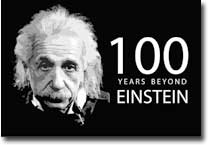The year 1905 was good for 26-year-old Albert Einstein, a technical assistant in the Swiss patent office.

Trained in physics and mathematics, Einstein took the office job because he couldn’t find a teaching position. That year, he published three papers detailing revolutionary theories related to space and time, quantum mechanics, and the existence of atoms. The ideas would rock the foundations of science and make Einstein famous.
“It was as dramatic a change as the introduction of cubism in art and jazz in music, both of which occurred at about the same time,” says Joel Bregman, professor of astronomy. Professor of Physics Dan Amidei, adds, “These papers laid the groundwork for much of the century of physics that has followed.”
To commemorate the 100th anniversary of Einstein’s achievement, the astronomy, physics and chemistry departments are presenting lecture programs. “The Invisible Universe: Einstein’s Legacy,” is a series of five lectures sponsored by the astronomy department, Exhibit Museum of Natural History and the Student Astronomical Society. The series opens at 7:30 p.m. Sept. 16 with Bregman’s lecture, “X-Raying Black Holes.” The lectures will be presented in the Chemistry building auditorium.
The “100 Years Beyond Einstein Physics Theme Semester,” sponsored by the physics and chemistry departments, will begin with the lecture, “What Astronomy has Done for Einstein,” by University of Oxford Professor Jocelyn Bell Burnell, discoverer of astrophysical pulsars, at 4:15 p.m. Sept. 21 in the East Hall auditorium.
How has Einstein impacted our lives? “Sometimes a thing is so big you can’t see it,” Amidei says. “The photoelectric and atomic hypotheses allowed the understanding of materials that underlie the modern electronic industry. Relativity changed our ideas about space and time, allowing the further development of cosmology, the understanding of the expanding universe, and our ideas about the ‘Big Bang.’ It also filters down to the small stuff. The photoelectric switch is used to open doors.”
“The conversion of mass to energy, E = mc2, is central to the production of electricity in every nuclear power plant,” Bregman says. “The GPS network of satellites would give us the wrong locations if we did not account for the speed of these satellites around the Earth, and we calculate that correction from Einstein’s theories.” The corrections also are crucial for spacecraft bound for planets in orbit. “So if you want to send a probe to orbit or land on a planet, you’d better know some relativity,” Bregman says.
“We do take a lot of his work for granted today,” says Sally Oey, assistant professor of astronomy.
“I think it’s remarkable that he has had an impact on so many different areas of physics,” Oey adds. “It’s important to use this as an opportunity to present his work and for the public to plug into science and technology.”
Einstein’s theory of relativity found that time and space, as perceived by a moving person, were not absolute. “This was so dramatic that it helped remove boundaries in the way we thought about things,” Bregman says. “It also showed that mass could be converted to energy, which is summarized by E=mc2, the most famous single equation in science.”
Later, Einstein showed that space was curved, which also was mind-boggling. “These remarkable revelations in our physical world gave generations of scientists the freedom to think of anything when trying to solve the mysteries of physics and astrophysics,” Bregman says.
FALL 2005 CAMPUS EVENTS COMMEMORATING KEY RESEARCH
PUBLISHED BY ALBERT EINSTEIN:
100 Years Beyond Einstein Physics Theme Semester
Lectures begin at 4:10 p.m. in 340 West Hall, unless noted.
Sept. 21—Jocelyn Bell Burnell, “What Astronomy has Done for Einstein,” 4:15 p.m.,
East Hall auditorium
Oct. 5—Martinus J. G. Veltman, “A Century of Particle Physics, ” 4:10 p.m.
Oct. 19—Anthony Leggett, 2003 Nobel Laureate, “Does the Everyday World Obey Quantum Mechanics?” Ta-You-Wu Lecture, 4:15 p.m., Rackham Amphitheatre
Nov. 2—Leonard Sander, “Brownian Motion and Beyond: Collective and Emergent Phenomena in Condensed Matter Physics”
Nov. 9—Katherine Freese, “The Expanding Universe and Big Bang Cosmology”
Nov. 16—Gordon Kane, “Future Particle Physics—Can we Understand the Smallest & Largest Phenomena Even Better?”
Dec. 7—Christopher Monroe, “The Second Quantum Revolution”
Fall 2005 Saturday Morning Physics lectures
Lecture schedule is at: http://www.physics.lsa.umich.edu/nea.
Oct. 1—Thomas Zurbuchen, “1905: Einstein and Bern, A Year to Remember,”
10:30-11:30 a.m., 170 Dennison building
Oct. 8—Martinus J.G. Veltman, “Origins,” 10:30-11:30 a.m.,
Chemistry building auditorium
Distinguished Public Lecture Series—The Invisible Universe: Einstein’s Legacy
The public talks begin at 7:30 p.m. in Room 1800 of the Chemistry building, followed by a planetarium show.
Sept. 16—Joel Bregman, “X-Raying Black Holes”
Sept. 30—David Weinberg, “Dark Matter and Dark Energy”
Oct.7—Angela V. Olinto, “Mysteries of the Extreme Universe”
Oct. 21—David Spergel, Orren C. Mohler Lecture, “The Size, Shape and Fate of the Universe”
Nov. 4—Ramesh Narayan, “Black Holes: Theory Versus Observations”

